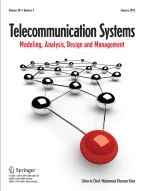Abstract
In this paper, we have investigated a technique to eliminate the sensing-throughput trade-off of the conventional method in the cognitive radio network. First, we have discussed the sensing—throughput trade-off caused by the conventional method in the cognitive radio network and then proposes a frame structure for eliminating such an issue which is presented in the conventional approach. However, the proposed method has a drawback, which is solved by the enhancement in the frame structure. We have numerically simulated and compared the throughput of cognitive users for both (conventional and propose) methods. The frame structure enhancement technique decreases the probability of frame collision between the primary and secondary users (SUs) and reduces the data rate loss.
Similar content being viewed by others
Explore related subjects
Discover the latest articles, news and stories from top researchers in related subjects.References
Akyildiz, I. F., Lee, W. Y., Vuran, M. C., & Mohanty, S. (2006). Next generation/dynamic spectrum access/cognitive radio wireless networks: a survey. Computer Networks, 50(13), 2127–2159.
Akyildiz, I. F., Lee, W.-Y., & Chowdhury, K. R. (2009). CRAHNs: cognitive radio ad hoc networks. Ad Hoc Networks, 7(5), 810–836.
Badoi, C.-I., Prasad, N., Croitoru, V., & Prasad, R. (2011). 5G based on cognitive radio. Wireless Personal Communications, 57, 441–464.
Federal Communications Commission, Spectrum policy task force report, FCC 02-155, Nov. 2002.
Ghasemi, A., & Sousa, E. S. (2007). Fundamental limits of spectrum-sharing in fading environments. IEEE Transactions on Wireless Communications, 6(2), 649–658.
Jandral, F. K. (2005). Software defined radio-basics and evolution to cognitive radio. EURASIP Journal on Wireless Communications and Networking, 3, 275–283.
Kay, S. M. (1998). Fundamentals of statistical signal processing: detection theory (Vol. 2. Englewood Cliffs: Prentice Hall.
Kapoor, S., & Singh, G. (2011). Non-cooperative spectrum sensing: a hybrid model approach. In Proc. of int. conf. on devices and communications (ICDeCom-11), India, 24–25 Feb. (pp. 1–5).
Kang, X., Liang, Y.-C., Garg, H. K., & Zhang, L. (2009). Sensing-based spectrum sharing in cognitive radio networks. IEEE Transactions on Vehicular Technology, 58(8), 4649–4654.
Liang, Y.-C., Zeng, Y., Peh, E., & Hoang, A. T. (2007). Sensing-throughput trade-off for cognitive radio networks. In Proc. of IEEE international conference on communications (ICC 2007), Glasgow, June 2007 (pp. 5330–5335).
Liang, Y.-C., Zeng, Y., Peh, E. C. Y., & Hoang, A. T. (2008). Sensing-throughput trade-off for cognitive radio networks. IEEE Transactions on Wireless Communications, 7(4), 1326–1337.
Mitola, J., & Maguire, G. Q. (1999). Cognitive radio: making software radio more personal. IEEE Personal Communications, 6(4), 13–18.
Navaie, K. (2011). On the interference management in wireless multi-user network. Telecommunication Systems, 46, 135–148.
Poor, H. V. (1998). An introduction to signal detection and estimation (2nd ed.). New York: Springer.
Singh, G. (2011). Optimization of spectrum management issues for cognitive radio. Journal of Emerging Technologies in Web Intelligence, 3(4), 263–267. (Invited paper).
Stotas, S., & Nallanathan, A. (2010). Overcoming the sensing-throughput tradeoff in cognitive radio networks. In Proc. of IEEE international conference on communication (ICC), Cape Town, 23–27 May 2010 (pp. 1–5).
Stotas, S., & Nallanathan, A. (2010). On the throughput maximization of spectrum sharing cognitive radio networks. In Proc. of IEEE. global telecommunications conference (GLOBECOM 2010), Miami, FL, 6–10 Dec 2010 (pp. 1–5).
Tang, L., et al. (2011). Opportunistic power allocation strategies and fair subcarrier allocation in OFDM-based cognitive radio networks. Telecommunication Systems. doi:10.1007/s11235-011-9486-4.
Tang, Z., Wei, G., & Zhu, Y. (2009). Weighted sum rate maximization for OFDM-based cognitive radio systems. Telecommunication Systems, 42, 77–84. doi:10.1007/s11235-009-9170-0.
Tzeng, S.-S., & Huang, C.-W. (2011). Effective throughput maximization for in-band sensing and transmission in cognitive radio networks. Wireless Networks, 17, 1015–1029.
Zhang, Y., & Leung, C. (2009). Cross-layer resource allocation for real-time services in OFDM-based cognitive radio systems. Telecommunication Systems, 42, 97–108.
Zhao, Q., & Swami, A. (2007). A decision-theoretic framework for opportunistic spectrum access. IEEE Wireless Communications, 14(4), 14–20.
Zhu, J., Wang, J., Luo, T., & Li, S. (2009). Adaptive transmission scheduling over fading channels for energy-efficient cognitive radio networks by reinforcement learning. Telecommunication Systems, 42, 123–138.
Author information
Authors and Affiliations
Corresponding author
Rights and permissions
About this article
Cite this article
Pandit, S., Singh, G. Throughput maximization with reduced data loss rate in cognitive radio network. Telecommun Syst 57, 209–215 (2014). https://doi.org/10.1007/s11235-013-9858-z
Published:
Issue Date:
DOI: https://doi.org/10.1007/s11235-013-9858-z
